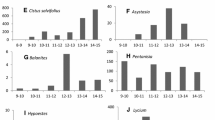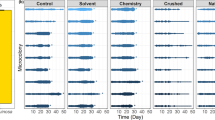Summary
Nectar-foraging pollinators often exhibit a directional pattern of movement between plants when the energetic costs of revisiting previously utilized areas can significantly reduce foraging efficiency. However, bumblebees (Bombus spp.) foraging for pollen on flowers of Aquilegia caerulea rarely moved in a straight line among successively visited plants. Most flights from plants visited were either to closely neighboring plants or were longer and involved bypassing near neighbor plants. Bees biased their flights toward plants with relatively large numbers of flowers yet visited only a small fraction of the flowers on each plant. Such foraging tactics might result when the energetic costs of revisiting plants are minor. Alternatively we suggest that bumblebees foraging for pollen may not perceive revisitations and their associated costs because they do not assess pollen returns on a per plant basis. In this case energetic-efficiency arguments predicting the pattern of foraging movements among plants may be inappropriate. A better level of analysis would be where the bees assess net energy returns, perhaps between bouts of pollen-combing and corbiculae-packing.
Similar content being viewed by others
References
Cody ML (1971) Finch flocks in the Mojave Desert. Ther Pop Biol 2:142–158
Cody ML (1974) Optimization in ecology. Science 183:1156–1164
Gill FB, Wolf LL (1977) Nonrandom foraging by Sunbirds in a patchy environment. Ecology 58:1284–1296
Heinrich B (1979) Resource heterogeneity and patterns of movement in foraging bumblebees. Oecologia (Berl) 140:235–245
Levin DA, Kerster NW, Niedzlek M (1971) Pollinator flight directionality and its effect on pollen flow. Evolution 25:113–118
Miller RB (1978) The pollination ecology of Aquilegia elegantula and A. caerulea (Ranunculaceae) in Colorado. Amer J Bot 65:406–414
Pyke GH (1978a) Optimal foraging: movement patterns of bumblebees between inflorescences. Theor Pop Biol 13:72–98
Pyke GH (1978b) Are animals efficient harvesters? Animal Behav 26:241–250
Slater PJB (1974) The temporal pattern of feeding in the Zebra Finch. Animal Behav 22:506–515
Smith JNM (1974a) The food searching behavior of two European thrushes: I. Description and analysis of search path. Behaviour 48:276–302
Smith JNM (1974b) The food searching behavior of two European thrushes: II. The adaptiveness of search patterns. Behaviour 49:1–61
Waddington KD (1978) Quantification of the movement patterns of bees: a novel method. Amer Midl Nat 101:278–285
Wolf LL, Hainsworth FR (1978) Energy: expenditures and intakes. In: Chemical Zoology. M Florkin and B. Scheer (eds), Vol X, New York: Academic Press, Inc, pp 307–358
Zimmerman M (1979) Optimal foraging: a case for random movement. Oecologia (Berl) 43:261–267
Author information
Authors and Affiliations
Rights and permissions
About this article
Cite this article
Hodges, C.M., Miller, R.B. Pollinator flight directionality and the assessment of pollen returns. Oecologia 50, 376–379 (1981). https://doi.org/10.1007/BF00344979
Received:
Issue Date:
DOI: https://doi.org/10.1007/BF00344979




